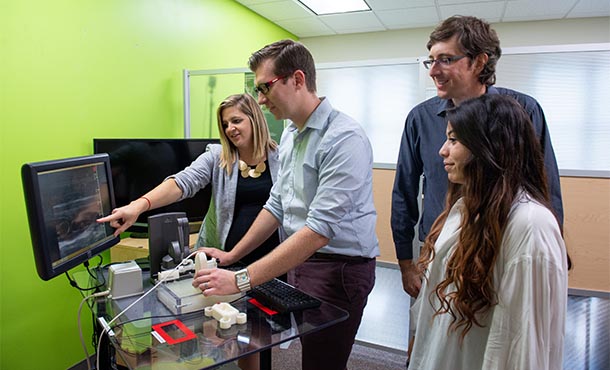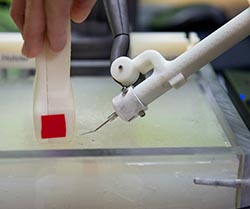
Led by Scarlett Miller, associate professor of engineering design and industrial engineering, and Jason Moore, associate professor of mechanical engineering, a multi-disciplinary and multi-institutional research team aims to develop an innovative robotic training system to reduce the number of complications associated with central venous catheter placement. IMAGE: TYLER HENDERSON/PENN STATE
Dynamic haptic robotic training to decrease catheter procedure complications
NIH grant supports multidisciplinary, multi-institutional, central venous catheter insertion research
10/24/2019
By Samantha Chavanic
UNIVERSITY PARK, Pa. — Each year, more than five million central venous catheters (CVC) are placed in a large vein in the neck, chest or groin to provide patients with fluids, blood or medications. The thin, flexible tubes empty their contents into or close to the heart, providing almost immediate treatment. Of these five million patients, close to 1.7 million experience some sort of complication related to the catheter insertion — that is one in every three patients.
A Penn State-led, multi-disciplinary and multi-institutional research team aims to develop an innovative robotic training system to reduce the number of complications associated with CVC placement.
Through a five-year, $2,233,411 grant recently awarded by the National Institute of Health’s National Heart, Lung and Blood Institute, principal investigators Jason Moore, associate professor of mechanical engineering, and Scarlett Miller, associate professor of engineering design and industrial engineering, will lead a team of engineers, medical professionals and graduate students to build upon their previous dynamic haptic CVC work supported by the NIH. Co-investigators include the project’s lead medical doctor David Han, professor of surgery and radiology at Penn State College of Medicine; Lisa Sinz, associate dean for clinical simulation at Penn State College of Medicine and professor of anesthesiology, critical care medicine and neurosurgery; and Philip Ng, medical director of the Procedure Center and Vascular Access Services at Cedars-Sinai in Los Angeles.
The new project will use the team’s innovative concept of dynamic haptic robotic training (DHRT), where a programmable robot is used to apply force to a surgical resident’s hand to replicate the feeling of inserting a needle into a patient’s body, to develop and implement an entire CVC procedural training system. The new DHRT+ system will integrate a mixed-reality smart tray, advanced testing surface, high-functional fidelity virtual ultrasound imaging and real-time, adaptive feedback assessment.
“The DHRT+ system is focused on not just decreasing and even eliminating the mechanical complications and the training of that, but also looking at the entire procedure, so from the moment that they start consenting the patient to the moment that they insert the final devices,” Miller said.
She explained that by focusing on the process from beginning to end, the team will decrease not only mechanical complications but also infectious complications. Infections can happen from not using appropriate sterile techniques, both before and after the central line placement.
Moore highlighted that by widening the scope to include sterilization practices and patient records review, the steps that people generally need to memorize will be included in the training process and these skills learned will transfer into clinical use.
“We can make it (training) be much more effective for the user and help eliminate some of the patient complications that we see,” he said. “If somebody is trained with the DHRT+, we hypothesize this will have a strong impact on patient well-being at the end of the day.”
To prepare residents for the patient diversity they will see in the clinic, the DHRT+ will simulate varying realistic insertion scenarios. The device will provide direct feedback and assessment to users, providing immediate results on what they did right and what skills need improvement. It will also connect to the DHRT+ Global Learning System, a centralized system that automatically stores and analyzes performance information and updates the DHRT+ simulation to continually improve learning performance.
Han, also an investigator on the original NIH grant, said while training residents with simulators is not new, the idea of incorporating structural design and the interface between the simulator and the learner to provide personalized, real-time, real-data feedback is. He feels the collaborative nature between engineers and medical professionals brings a different perspective to the project — leading to innovative solutions that might not otherwise come to be.
“Collaborating with researchers who bring a different perspective is incredibly valuable to identifying, developing and creating new methods and techniques,” Han said.
Currently, there is no standardized training procedure for catheter insertion training throughout the health care industry. Through a connection due to their previous DHRT work, the Penn State team invited Ng and Cedars-Sinai to become part of the project, creating the multi-institutional component needed to take the research to the next level. Through the partnership with two medical facilities, Penn State Health Milton S. Hershey Medical Center and Cedars-Sinai, the team expands their research population, ultimately leading to more accurate system adoptability and implementation data.
Ng, who was fascinated by the system’s ability to change scenarios and track time and needle entry angle, said the project has all the necessary facets to address the issues with current simulation training.
“It’s one thing to be really proficient on a simulator, to be fast and accurate, but it’s a different thing to say that the learning in the sim center gets translated to the bedside and results in fewer complications, improved safety and less stress on everybody,” he said. “Every case that they do in the sim center should be viewed as learning a different tool they will put in their toolbox so that when they are faced with an actual clinical scenario out there, they can reach into their toolbox, apply what they’ve learned and get the right tool for the right job.”
Ultimately, the team hopes to translate what is learned with the DHRT+ to the bedside, leading to improved patient safety and comfort.
“As engineers and engineering designers, we are constantly trying to create innovations,” Miller said. “We always say, ‘It could be you in the hospital setting having this procedure done.’ The training of that person leading up to that moment is really important. It’s not just you — it could be your family member or close friend having this done. The reason that drives me to improve our health care system for this procedure that is done so commonly, but has such a high complication rate, is that opportunity to have that impact on people’s lives.”



